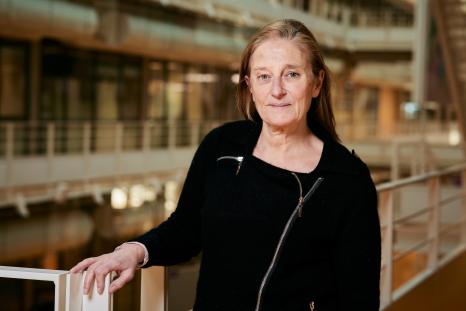
Laure Quivy: when numerical analysis challenges randomness
Laure Quivy is a lecturer at the Centre Borelli (Univ. Paris-Saclay, National Centre for Scientific Research CNRS, ENS Paris-Saclay, Univ. Paris-Cité, French Defence Health Service SSA). Specialising in numerical analysis and scientific computing, she is also deeply committed to education and promoting diversity.
After completing her scientific baccalaureate, Laure Quivy developed a passion for mathematics, which led her to the University of Western Brittany, where she obtained her undergraduate degree in this discipline. In search of further specialisation, she joined Université Paris-Sud (now Université Paris-Saclay) in 1985. It was there that she earned her master's degree and embarked on a Diploma of Advanced Studies (DEA) (equivalent to a 2nd year research-based master's degree) in numerical analysis, an innovative course at the time. Her studies led to her thesis, which she conducted in an industrial environment in partnership with EDF's research and development department. At the same time, Laure Quivy became involved with the Centre for Mathematics and its Applications at the École Normale Supérieure Paris-Saclay (ENS Paris-Saclay), since renamed the Centre Borelli, which has subsequently undergone significant development.
Exploring ferroresonance
Laure Quivy's thesis sat at the intersection of physics and mathematics, focusing on the study of ferroresonance, a complex phenomenon affecting electrical circuits. Mathematically, she explored nonlinear dynamical systems, using bifurcation theory, often associated with the chaos theory popular at the time. Her thesis, defended in 1991, provided innovative numerical results on these dynamical systems and offered theoretical insights into the partial differential equations underlying these models. In particular, Laure Quivy highlighted the existence of maximal attractors, guaranteeing the existence of a set of states towards which the solutions evolve. "Contrary to some preconceived ideas in the industry, we came to the conclusion that these systems are not purely chaotic. Their behaviours can be predicted and therefore controlled." This work provided practical solutions for preventing surges on power lines and improving reliability.
Between teaching and developing new programmes
After her thesis, Laure Quivy joined the University of Villetaneuse (now Sorbonne Paris Nord) as a temporary teaching and research associate (ATER) for one year. She later became a lecturer at the Bobigny Technical Institute (IUT), affiliated with the same university. While her involvement in business and administration management programmes may come as a surprise, mathematics still found its place there. Indeed, Laure Quivy appreciated the diversity of the disciplines represented and the synergy with colleagues from different backgrounds. She was actively involved in this Technical Institute, particularly through her involvement in the creation of a work-study programme in 2000. "For me, passing on knowledge is paramount. And in a context where the majority of students come from less affluent backgrounds, the work-study programme was the ideal solution, combining theory with paid work experience."
Due to the proximity of the Bobigny Technical Institute to the Faculty of Medicine, in 2010, several discussions highlighted the fact that many students drop out of medical school during their first year. The decision was then made to create a new department within the Technical Institute and Laure Quivy took responsibility for a new programme in biological engineering. Scheduled to start in February, it offered a professional transition without losing a year, to educate technicians in this discipline.
Centre Borelli: education, research and diversity
In 2011, Laure Quivy joined the department of teaching and research in mathematics at ENS Paris-Saclay and the Centre Borelli. There, she taught courses, pursued her research and quickly took on administrative responsibilities. She was put in charge of the 3rd year undergraduate degree in mathematics at ENS Paris-Saclay, before becoming Deputy Director of the department of teaching and research in mathematics at ENS Paris-Saclay. Since September 2023, she has been its Director. Her vision is clear: to offer students the best conditions to succeed in their studies. She is particularly interested in diversity within the institution. Aware of the inherent biases in the competitive exam system, she advocates for opening up to more varied profiles, especially by recruiting students outside the competitive entrance exam process of ENS Paris-Saclay. This approach also aims to encourage female participation, which is still under-represented in this field. "It is essential to give these talented young women a chance, as they are capable of becoming excellent researchers if given the opportunity. I am delighted that this year, four of the eight places available for students outside the entrance exam process of ENS Paris-Saclay have been filled by women. In contrast, we have recruited less than 10% women through the competitive exam."
Research work in numerical analysis
Laure Quivy's scientific contributions in numerical analysis and scientific computing are varied. Her main focus is on the theoretical and practical design of numerical schemes for finding approximate solutions to the nonlinear partial differential equations often used in physics. Over her career, she initially focused on minimising the relaxed energy functional in the study of the behaviour of liquid crystals, exploring in particular the influence of magnetic fields on their equilibrium energy. She then turned to the analysis and development of finite volume schemes designed to simulate complex flows, such as water-vapour interactions in nuclear power plants or airflows around aircraft wings. These studies have direct implications, ranging from optimising the aerodynamic shape of aircraft to improving water and steam circulation in nuclear facilities. Then, Laure Quivy became interested in interface tracking, particularly in vacuum processing models. Working with the French Alternative Energies and Atomic Energy Commission (CEA) and members of its laboratory, she conducts studies on behalf of civil and military industries. This research highlights the challenges posed by transient vacuum phenomena arising from shocks. "Conventional industrial numerical schemes do not know how to handle this discontinuity, so we performed modelling to develop more suitable ones, which manufacturers then adopt to manage these complex phenomena."
Mathematics flirts with metaphysics
Since the start of her career, Laure Quivy has been driven by a question: are complex phenomena intrinsically deterministic or random? "Even though I've never incorporated randomness into my models and I am inclined towards determinism, I am very curious about the work of my probabilistic colleagues!" This question, bordering on metaphysics, is the common thread running through her work. According to Laure Quivy, invoking randomness is often a way of masking explanatory shortcomings. She uses climate change as an example: long considered to be unpredictable, in her opinion, it would instead reflect a lack of tools for understanding it. "Nevertheless, I recognise the beauty and importance of chance in life. If everything were predictable, where would the charm of those unexpected encounters be, whether friendly or romantic?"

